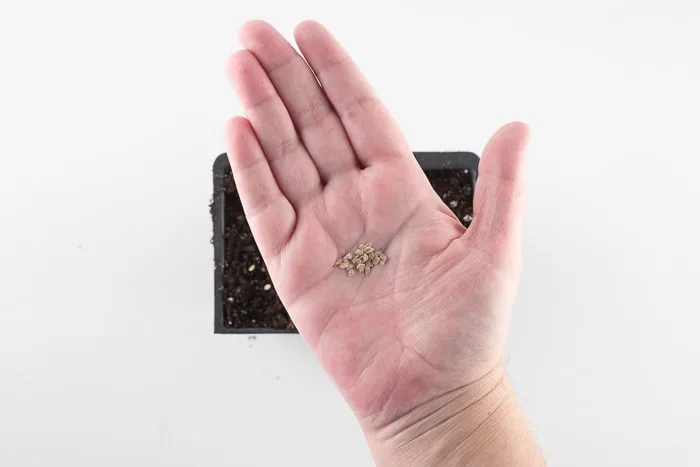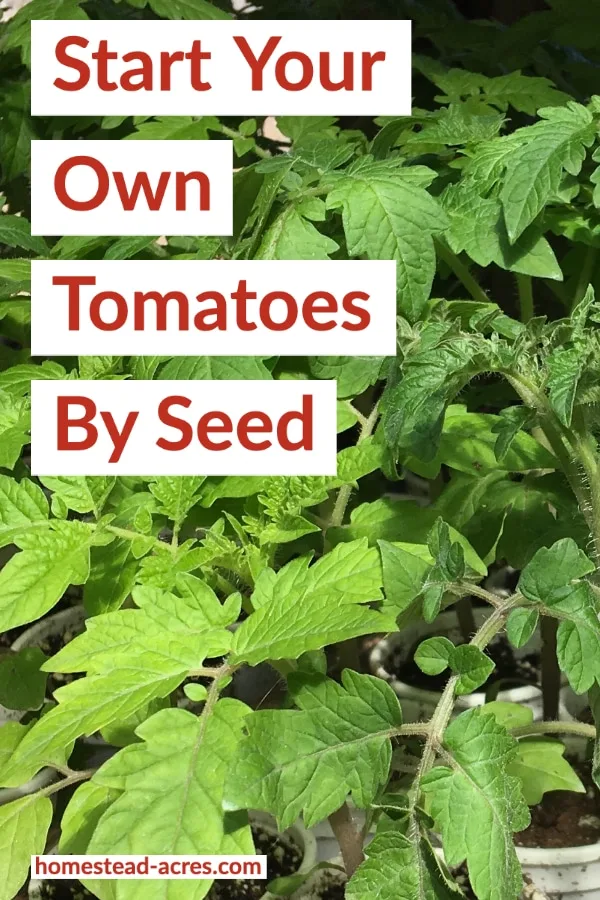This post may contain affiliate links, my full disclosure can be read here. As an Amazon Associate I earn from qualifying purchases.
Learning how to start tomato plants from seed opens up a huge world of tomato varieties you can grow in your garden. Planting tomato seeds can save you a lot of money in your garden too.
I’ve been growing tomatoes most of my life and they have to be my favorite vegetable (ok it’s a fruit) to grow in my garden.
The cost of buying tomato plants from your local nursery can run anywhere from $2 for 4 small plants up to $20 for a larger patio tomato plant.
Often these plants are in containers that are way too small for them and look good only because they are fertilized often with commercial fertilizers.

But for about $2 you can buy enough seeds to grow many tomatoes in your garden and make sure they have the best growing conditions possible.
Most greenhouses also only carry a few tomato varieties and mostly hybrids.
But by starting your own you can choose from a huge number of tomatoes from heirlooms to hybrids that have the best flavor and fit your growing zone the best.
Why You Should Start Tomatoes Indoors
Tomato plants are normally started by seed indoors 6 to 8 weeks before your last frost date in the spring.
Tomatoes are warm-season plants and need a head start to get them growing so that you can harvest fruit starting in mid-summer.
The days to maturity listed on packages of tomato seeds are from the date you transplant the seedling into your garden.
So if you are growing a 60-day variety it is assuming that you are planting a 6 to 8-week old seedling into your garden, then you can expect the plant to start producing tomatoes 60 days after that date.
If you started the same tomato variety by planting seeds directly in the ground, it could take up to 80 days for it to start producing.
See why it’s important to start tomatoes from seed indoors?
How To Start Tomato Plants From Seed

Mix your seed starting mix with warm water until it’s well moist but not soggy. It should just hold together when you squeeze it isn’t a ball but not drip water.
Fill your planting containers, and press the soil down firmly to remove any large air-spaced but don’t compact it.

Place 2 seeds into each cell and cover with about 1/4 inch of soil. Gently press the soil down so that it has good contact with the seeds.
Alternatively, you can also use a pencil or small stick to poke a hole 1/4 inch deep, drop in the seed and then cover it.
Water or mist from the top to moisten the top layer of seed starter. You don’t need to soak the soil since you’ve already moistened it you just want to make sure the new layer on the top is wet.
Place a plastic dome over your seed starting trays to help hold in the moisture. If you don’t have one then you can use plastic wrap from your kitchen to lay over top.
Place the seed trays in a warm place. On top of a heat mat is perfect but if you don’t have one you can use the top of your fridge or a sunny window.
At this stage, they don’t need light, but they do need warmth to germinate.
Keep the soil moist but not soggy, remember that the containers may need to be watered often if they are on a heat mat.

Check on your plant trays every day and when you see them starting to germinate remove the plastic dome and place them under your grow lights or in a sunny window.
How Long Does It Take Tomatoes To Grow From Seed?
Tomato seeds take an average of 7 to 10 days to germinate after planting. You can make tomato seeds germinate faster by using a heat mat to set your seed trays on.
This helps to keep the soil at an ideal temperature for seeds to sprout, and I’ve found that my tomatoes start to come up in 5 days and have a higher germination rate than without using a heat mat.
Caring For Your Tomato Seedlings
Lighting
If you are growing your tomato plants under grow lights remember to keep the lights 2 inches above the tops of the seedlings.
If they are too far away your seedlings will become leggy and week as they grow too tall trying to reach the light.
But you also don’t want the lights to touch the plant leaves as they can burn them. So make sure to raise the lights as the plants grow.
Set your timer so the lights are on for 12-18 hours a day.
If you are growing in a windowsill, turn the pots at least once a day. This will help the plants to grow upright rather than leaning towards the window.
Thinning
If you planted more then one seed in each cell or pot you’ll want to thin it down to one in each.
This can feel like a hard thing to do, but if you leave the extra plants in the same pot they will all struggle to grow.
Select the strongest, healthiest looking seedling to keep and using a pair of small scissors cut the remaining seedlings off at the soil surface.
Fertilizing
When tomato seedlings are very young they don’t need any fertilizing. But once the first set of true leaves has grown in you can start feeding the plants.
Use a water-soluble fertilizer, liquid fish emulsion is my favorite to use, mixed at half strength and applied weekly.
Repotting

As your tomatoes grow they will need to be transplanted into larger pots. It’s very important not to let your plants become root-bound (sometimes called pot bound).
That means that as the roots fill the growing container they will start to spiral around the outside and bottom of the container.
When the roots run out of room to grow it also causes the tomato to slow slower and can stunt the plant.
Planting Into The Garden
Tomatoes are a frost-tender plant, which means that they can’t take cold weather or frosts without damage to the plant.
Wait until after your last frost date to transplant tomatoes into your garden.
But make sure you have frost protection on hand in case you get an unusual cold spell after planting.
Using a floating row cover or a homemade plastic greenhouse to cover your plants with will also help protect them from the cold spring winds.
How To Start Tomato Plants From Seed
Equipment
- Heat mat (optional)
Materials
- Tomato seeds
- Seed starting mix
- Seed starting trays or pots
- Water
Instructions
- Mix the seed starting mix with warm water until it’s well moist but not soggy. It should just hold together when you squeeze it into a ball.
- Fill your planting containers, and press the soil down firmly to remove any large air-spaced but don’t compact it.
- Place 2 seeds into each cell and cover with about 1/4 inch of soil. Gently press the soil down so that it has good contact with the seeds.
- Water or mist from the top to moisten the new top layer of seed starter that you covered the seeds with.
- Cover with a plastic dome over your seed starting trays to help hold in the moisture. Alternatively, you can use plastic wrap from your kitchen to lay over top.
- Place the seed trays in a warm place, on a heat mat, on top of the fridge or a sunny window. At this stage, they don’t need light, but they do need warmth to germinate.
- Water as needed to make sure the soil is moist but not soggy.
- Check the plant trays daily and when the seeds start to germinate remove the plastic dome and place them under your grow lights or in a sunny window.
Connect With Homestead Acres!
Be sure to follow me on social media, so you never miss a post!
Facebook | Twitter | Pinterest | Twitter
Visit my Amazon store to find all my favorite gardening, homesteading tools, and gadgets plus all of my printed garden books and journals!

Kim Mills is a homeschooling mom of 6 and lives on an urban homestead in Ontario, Canada. Blogging at Homestead Acres she enjoys sharing tips to help you save money, grow and preserve your own food.



Normanda
Monday 11th of March 2024
Thank you for adding a way to print your information. very much needed on the web site for all tips and recipes